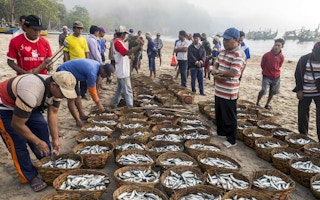Indonesia’s efforts to protect its fisheries, an important food source for the world’s fourth most populous country, by seizing and blowing up foreign poaching vessels has become well known globally and is paying off.
But, poaching is not the only problem the country’s intensively fished seas face. From the moment seafood are caught by local Indonesian fishers to being served on our plates, almost 40 per cent of them are lost and wasted due to poor fishery management. That’s worth around US$7.28 billion worth of fish products annually.
Indonesia wastes around 300 kilograms of food per person per year: seafood being among those deliberately thrown out. At the same time, 19 million people—or around 8 per cent of the total population—are still undernourished.
Food loss and waste is part of Sustainable Development Goal (SDG) number 12, which is responsible production and consumption. Unfortunately, the targets under this SDG mention no sectors. At the same time, most fishery-related SDGs are listed under SDG 14 on conservation and sustainable use of marine resources. However, this SDG target does not mention fish loss and waste issues.
As such, reducing fish loss and waste is not completely owned by the fishery sector as part of their SDG achievement, nor is it by other groups. This should change.
Why are we losing and wasting so much fish?
Under the rain and burning sun, highly perishable fish need to be transported long distances to reach markets in Indonesia. It could take months for fish to travel from the sea to local markets or foreign retailers.
The quality of these fish can deteriorate very quickly without proper management to transport and store them, resulting in unintentional losses.
On fishing boats, fishers often deliberately discard some of the fish they’ve caught. They waste these fish to keep space in their refrigerators and ice boxes for more valuable fish.
On land, fish can quickly rot if they are unloaded on jetties with no roofs and soaked in water for too long. Fish sellers have to throw these away due to their poor quality.
The recent data show bad fishing practices, such as throwing away unwanted catch at sea, potentially contribute to 8.2 per cent of Indonesia’s seafood waste and loss.
Another 6 per cent of losses are due to poor transportation and poor storage systems, 9 per cent due to poor processing and packaging processes, and 15 per cent due to bad distribution networks.
“
Bad fishing practices, such as throwing away unwanted catch at sea, potentially contribute to 8.2 per cent of Indonesia’s seafood waste and loss.
Better monitoring by governments and NGOs
Government officers have provided information to fishers about how important it is to preserve the quality of fish. The government has also built dedicated storage facilities and fish landing sites, where fishers can unload their catch and prevent them from quickly perishing.
To monitor what fish species are being caught, the government record captured fish species and their weight. But, neither governments or NGOs have yet regularly collected data on fish loss and waste.
While it is difficult to monitor fishing practices at sea—it’s hard to tell if fishers keep all their catch or throw away some that they do not want—it is possible to monitor fish loss and waste on land.
Governments, such as Indonesia’s Ministry of Marine Affairs and Fisheries and European Union as fish importers, and NGOs such as Marine Stewardship Council (MSC), an independent organisation that sets standards for sustainable fishing practices, should play a more active role in controlling fish loss by modifying their monitoring process and certification.
To issue catch certifications—currently intended to help Indonesia combat illegal, unregulated and unreported fishing practices—Indonesia’s Ministry of Marine Affairs and Fisheries use the data on captured fish species and its weight after landing.
The ministry can improve on this certification process to encourage fishers to reduce fish loss and waste.
Those working in the fishery sectors from fishers, traders, to fish processors who can prevent the most fish loss may receive incentives, increasing their motivation to preserve the quality of fish in their handling of them.
The ministry is also piloting an integrated system, called STELINA, to help fisheries business actors to meet policies and export regulation of destination countries. STELINA connects all supply chain information system as electronic tracking records.
The government should include in the system a certification that assesses fish loss and waste too.
Meanwhile, the Marine Stewardship Council (MSC) could modify its monitoring process before issuing its two eco-labelling certifications. MSC requires exporters and their suppliers to prove that their fish came from areas with healthy fish stocks and that fishing operations have minimal environmental impact. It also requires all fish coming from certified sustainable fisheries are identifiable, traceable and separated from other non-certified fisheries along the value chain.
MSC’s traceability system can be further developed to also assess fish loss and waste. But, they have not yet used it for that purpose.
MSC stated that their vision is to safeguard seafood supplies for future generation. So, minimising seafood waste and loss aligns with their vision, and we argue, should be part of their activities.
Calculating benefits
No one doubts the benefits of reducing seafood waste to local fishers, consumers, the nation and the environment.
For fishers, it will help them reduce financial loss.
Consumers can save their money to get better fish products.
The whole fishery value chain will be more efficient and, eventually, it will benefit the nation’s economy.
It will also be good for the environment as the system will require fewer resources and emit less greenhouse gas.
Every gram of 9 million metric tonnes of seafood that’s wasted and lost is nutrients taken away from malnourished children in Indonesia. Compensating for the lost and wasted fish by fishing more resources will deplete our ocean. Regulating fish loss and waste is not easy, but it is worth the effort to save $7 billion every year for the benefit of the Indonesian people.
Mulia Nurhasan is a researcher at the CGIAR System Organisation. This article was originally published on The Conversation.











